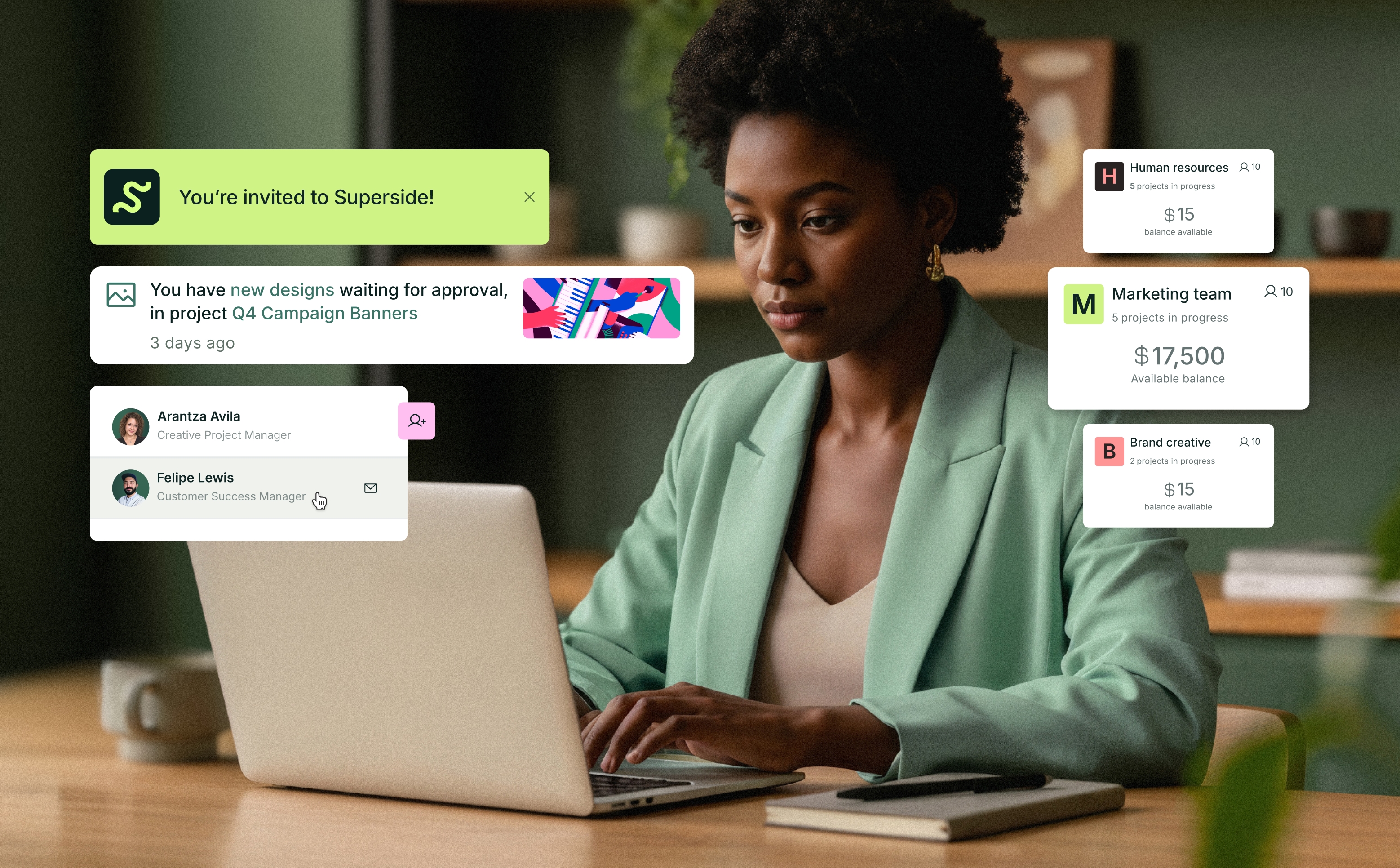
For designers, getting feedback like “Can you make this POP?” leaves far too much room for interpretation. Without clear, direct, and actionable feedback, you'll likely be giving another round of feedback and change requests that no one wants.
For those assigning work to designers, it can be frustrating to provide a detailed design brief only to have the designer take complete creative freedom and not fulfill the project outline.
But, when feedback is embedded into the design process and done properly, it can drastically improve your end results—and is ultimately a win-win for both sides.
As you start to level-up your skills, you may be wondering about some of these design feedback questions:
- The importance of Effective design feedback
- 7 ways to give better design feedback
- Design feedback questions
We’ll be tackling all of this and more below.
Let’s dive in!
The Importance of Effective Design Feedback
Feedback is essential to the design process. That’s because most designers aren’t designing for themselves, but instead fulfilling a brief. Whether it’s a social media campaign for marketing, a set of icons for the product team, or brochures for sales, every piece a designer works on will go through a set of revisions.
Enter design feedback.
When delivered effectively, design feedback can:
- Help designers grow: As a manager any opportunity to provide constructive feedback will help your designer improve their skills while building a better understanding of the brand (or a client’s brand).
- Speed up projects: When you pair clear expectations with effective feedback, you and your designers are more likely to finish each project faster. That means less time spent sharing feedback back and forth.
- Get the end result you envisioned: As a non-designer giving design feedback, delivering it effectively ensures that the design you get in the end is the one you envisioned at the start (or even better!).
7 Ways to Give Better Design Feedback
Now that we understand the impact of effective feedback, here's how to give design feedback for better results.
- Implement a Standardized revision model
- Direct feedback at the design, not the designer
- Describe the problem, don't assume you know all the solutions
- Leverage the right design feedback tools
- Keep all of your feedback in one place
- Be descriptive with your feedback
- Give positive feedback too
1. Implement a Standardized Revision Model
Standardizing your design process helps set expectations with your designers and makes it easier for you to manage the process (your Design Ops person/team will thank you).
The biggest thing I've found over my time is, at the beginning of the campaign, choose who's going to be in it and who are the decision-makers. Specifically looking at the CEO or CMO, ‘Hey, if you want to be involved in this, you've got to be involved in all the meetings. You can't just have someone come in at the end and go, Oh, I don't like this.'
– Bill Macaitis, Ex-marketing leader at Slack, Zendesk and Salesforce
A simple design revision process requires:
- Determining who the key stakeholders are at start of the project.
- Providing a detailed design brief to guide everyone throughout the process. Include visual references of past projects and inspiration for desired output.
- Defining a set of milestones for revisions and changes (e.g. first round to identifies major issues, second round to ensures changes and tweaks are made, and final round to approve the design)
- Giving consolidated feedback to save time, collect feedback from every stakeholder and consolidate before sending it to the designer.
The feedback features on Superside help you prioritize transparency throughout the progress of your projects and allow you to quickly collect feedback all in one place.
2. Always Direct Feedback at the Design, Not the Designer
“Don’t take this personally, but…”
“No offense, but…”
The word, "but" negates everything that came before it. When sharing feedback, remove the designer from the picture and focus on the design. After all, this could be the result of a bad brief, not necessarily the designer's skill. This should be reflected in the language you use, along with your overall feedback approach.
Bad feedback: “No offense, but I think this looks like it was designed by a child.”
Good feedback: “Using neon orange text over the neon blue background makes it hard to read. Can we use white text instead and consider readability for future designs?”
When asked how she preferred to receive design feedback, Mina Adame, Senior Product Designer at IBM said, “I like honest, critical feedback. I want people to be kind, but ultimately I want to improve as a designer.”
Maintain a positive relationship with your designers to keep their motivation high throughout the project. Never make feedback feel like a personal attack. Instead share constructive feedback that helps them grow while elevating the design.
This brings us to our next point:
3. Describe the problems, don't assume you know all the solutions
A design leader may give their team member to help push them to think of creative solutions. Instead of outright giving an answer, they can probe and nudge them towards a solution. For the sake of clarity, we’ll call this method “growth feedback”.
Growth feedback: “I like how this email header is looking, but there seems to be some overlap between the text and illustration. How would you improve this? Consider that someone opening an email will need to be able to digest the content quickly!”
As a non-designer, don’t try to tell designers how to design—you’re not the expert here. Instead, tell them what you’re looking for and where the design is currently falling flat.
This can include sharing context like:
- Based on the marketing team’s data, images with people perform better compared to those with animals
- For Facebook approvals, remember to stay within the text length recommendations and design ratios
- When creating banner ads, use contrasting backgrounds that stand out on a webpage which are typically white or black
Help your designers understand the why behind the changes to ensure they’re not designing in the dark. Describing the problems ensures that you don’t have to provide the same feedback the next time they work on a similar project.
The Superside platform encourages conversation and a problem-solving mindset through its feedback features. When leaving feedback within the in-app document viewer, you can tag teammates, reply to specific comments and even resolve comments. This helps you focus the conversation, and keep your project moving toward its finish line.
Tag teammates, reply and resolve comments in the Superside platform to keep feedback clear and focused.
4. Leverage the Right Design Feedback Tools
Are you using design management tools with your team to ensure that feedback and design collaboration are encouraged from both ends?
From the perspective of an in-house design team, standardize your design team’s tech stack to ensure file compatibility for all designers and everyone understand how to provide feedback.
Some design management tools to consider include:
- InVision: A collaborative digital product design platform that’s mainly used by UX designers.
- Figma: A collaborative design tool that enables teams to build everything from prototypes to designs.
- Pitch: A presentation software that allows teams to collaboratively build pitch decks and other presentations.
- GoVisually: An online proofing software that gives designers an easy way to collect feedback, and sign-off on designs and videos.
However, when it comes to outsourcing your design work, you’ll find that your designers will have their own tech stack and each will differ. Either find freelancers who use the same tools, or make sure there’s an easy way to provide feedback.
In Superside, you can give stakeholders access to your project by adding them as collaborators by adding their email to the project or sharing the project link with them. This effectively gives them access to the brief and every version of your project’s design files. More importantly, directing stakeholders to deliver all their feedback in one place ensures nothing falls through the cracks and that there is a transparent conversation around the progress of the project.
Easily add teammates as collaborators in the Superside platform.
At Superside, we have a whole design management platform allows your to:
- Upload existing brand assets
- Chat with their project manager
- Comment on different designs
- Add more teammates
- And plan out design project
5. Keep All of your Feedback in One Place
For a designer, nothing is more frustrating than sifting through emails, Slack messages and other collaboration tools to gather all the feedback together. So when sharing feedback with designers, do it all in one place.
Doing this also leaves less room for missing a piece, or duplication of feedback, requiring you and your designer to go through yet another round of edits.
The place you document your feedback is less important than your consistency of platform. So, whether you’re using Superside, or one of the tools mentioned above keep all of your feedback in one place.
6. Be Descriptive with your Design Feedback
InVision interviewed several designers to learn about the worst feedback they’d ever received from a client.
This list included feedback like:
- “I’ll know it when I see it”
- “Use something in between serif and sans-serif”
- “Make it more creative”
If you want to avoid ever seeing your words in an article like this, then always be descriptive with your feedback.
When sharing design feedback, try including some of these elements:
- Design brief
- Target audience
- Colors
- Fonts and sizes
- Spacing
- Images used
- Image or canvas size
Bad feedback: “My wife’s favorite color is blue. Can we make the site more blue?”
Good feedback: “Can we change the navigation menu’s font color to blue? I want to include our brand colors more across the website to build familiarity with our audience.”
When giving feedback on Superside, you can leave general comments or marked comments that allow you to pin your comments on the exact spot on the asset you’re referring to. Using marked comments help you avoid confusion when you're giving more granular, descriptive feedback on a design.
Get granular with marked comments in the Superside platform.
7. Don’t Forget about Positive Feedback
When asked about giving feedback to designers when their work isn’t quite up to par, Greg Storey, a former Senior Design Director at InVision said:
I generally begin with what people are doing well. It’s too deflating for them if you start by immediately identifying all the things that are wrong. There’s a tipping point when any more negative feedback could shatter their confidence. If it’s really bad work, I ask them to stop and have a different kind of discussion. There are times where you may need just to say, ‘Stop, we need to reset.’
When sharing constructive design feedback, dont focus solely on your desired changes because it can feel incredibly overwhelming for a designer.
Instead, as Greg mentioned, start with what you like or love, ask question where there may be confusion, and then move onto the constructive feedback or changes you had in mind.
Design Feedback Questions
There is a lot of information which makes design feedback an easier thing to do. There are also a lot of popular questions on the topic which we have answered below for you, if you were wondering about these yourself.
What is the role of feedback in the design process?
Feedback creates the loop between designer, manager, and client and without it, any design project will likely fail. Quality feedback builds trust and helps all parties to understand the capabilities of the designer and ensures timely delivery of a design the client envisioned.
When is the ideal time to give design feedback?
You want to give design feedback as early as possible, so it’s fresh in the designer’s mind. However, try to consolidate all your feedback into one document from all interested parties, including the client, so the designer can move forward with the specific details and revisions they need.
What kinds of feedback produces the best results?
A standardized feedback and revision model ensures everyone knows what to expect, so follow it accordingly. Your feedback should be focused on the design, not the designer. Then, be sure to ask questions about the design—before judging, seek to understand why they went a certain direction. Once you understand their process, communicate the problems, not solutions.
Let the designer fix what you see as problems and feel free to provide loose suggestions, but ultimately let the designer design. Be descriptive, focus on specific areas, and do your best to keep the conversation and overall feedback positive.
Who should be looped into the feedback process?
It’s best to try to limit opinions to key stakeholders and active participants in the design feedback process, but it’s not always possible depending on how feedback is given. If it takes place in a boardroom, for instance, it’s difficult to control who speaks.
If you can, gather all feedback from key stakeholders into one doc and let the designer speak to the feedback so everyone can hear the next steps and updates. Let others follow the same process by informing them the purpose is to brainstorm alternative approaches, not tear down the current work.
What are examples of constructive feedback?
Constructive feedback should focus on observation, not subjective reasoning.
1. Focus on the design, not the designer. Ignore what you’re heard from others and make your own opinion.
Don’t say “Paul hates the orange color you use in the background. You keep using it and I think it’s ugly too.”
Do say “Do you think there’s something we could change about the orange background? Can we try a different color that may be more on brand or help the text stand out better?
2. Positive critiquing should focus on what can be improved, not something out of the designer’s control.
Don’t say “I know the client wants this as a static ad, but let’s turn it into a motion graphic.
Do say “Once you finish with this static ad, I’d like to see if we can add some motion elements. After submitting it to the client, can you copy me on it so I can ask the motion designer if they have any time. It’d be great to show the client what’s possible.”
To stay constructive in your feedback, start by identifying what you’ll be discussing and then say what you’re seeing and how it makes you feel noting that it’s personal. Ask and allow the designer to respond to the feedback to reach common ground and understanding. Discuss solutions, offer suggestions, and summarize to ensure clear next steps.
Wrapping up
When delivered the right way, feedback can accelerate the graphic design process, keep your designers engaged in the work they’re doing, and deliver a better final result. But, it’s important that, as you scale your design team, your feedback process scales with it.
So, the next time you deliver design feedback, don’t forget to:
- Be specific
- Leverage the right tools
- Describe the problems, not just the solutions
- Implement a standardized revision model
If you’d like to learn more about how to scale your design team and your feedback processes, check out The Future of Design Ops. In this eBook, you’ll access insights from Pinterest’s former Head of Design Ops, Meredith Black, Amazon’s Creative Operations Manager, Jason Henrickson, and many others who are blazing the trail.












